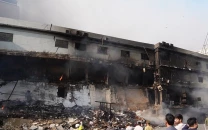Eurasian integration for socio-economic development
Asia and the Pacific’s trade grew 29.6% in first three quarters of 2021, compared with global trade growth of 27.8%

Connectivity and embracing technology are the driving forces for socio-economic development of any region. Asia is leading from the front in this change. The vast natural resources, good human capital, geographical endowments and geopolitical significance in world affairs have blessed.
Asia with a unique edge over other continents. Benefitting from liberal market economy, last few years have witnessed Chinese rise as the second biggest economy of the world and Russian resurgence.
However, ensuing great powers competition exacerbated by the Russia-Ukraine War, hedging measures in the liberal market economy, denial of technology, rise of the state and nationalism, the US exit from Afghanistan and resurgent terrorism in South Asia are gradually veering the world to de-globalisation with attended consequences; the major one being default closeness and integration of Eurasia. Connectivity, liberalisation and facilitation of trade and investment are strengthening Asian integration.
Regional cooperation and integration have already played an important role in helping Asian countries in their development over the past 50 years that can be improved further by peace and stability; as President Xi Jinping said the “old silk roads thrived during times of peace”. Asia is the world’s largest manufacturer and one of the largest markets too. Seven of the top 10 countries in terms of foreign reserves are Asian.
Asia is now the largest foreign direct investment destination and is likely to contribute 50% to the world’s trade growth by 2030. It is emerging as geo-economics destiny of the world. In the 21st century, Asia led in social mobility and overcoming abject poverty. Asian dependency on Western supply chain system has decreased significantly too.
Asia and the Pacific’s trade grew 29.6% in the first three quarters of 2021, compared with global trade growth of 27.8%. According to the Asian Economic Integration Report (AEIR) 2022, trade within the region rebounded by 31.2% during the same period. Intra-regional trade made up 58.5% of the region’s total trade in 2020, the highest share since 1990. SCO, ECO, ASEAN, AEC, CAREC, GMS, BIMSTEC SAARC EAEU and lately BRI, etc are examples of multilateralism.
These forums can surely contribute more to mutually beneficial economic integration of Eurasia. The BRI is, however, seen by USA and West as a way to re-orientate world economic system to the East, which China denies vehemently. The global economy is currently undergoing significant rebalancing. Asia can play a central role in sustaining global growth.
Russia seeks new markets, and China also looks for newer markets for its affordable commodities. Russia has become a top market for Chinese companies, filling the vacuum left by departing Western brands. Vietnam and India are emerging as newer players in the consumer suppliers. Successful logistics management calls for consistent innovation and leveraging available technology.
The Asian Development Bank estimated that developing transport infrastructure in Asia will need $1.5 trillion per year, through 2030. This amount increases to $1.7 trillion per year due to climate change mitigation requirements. This investment shall multiply benefits of connectivity. A new financial mechanism is emerging in Asia. Yuan, ruble and the yen are trying to establish their place. Moscow is pursuing a policy of de-dollarisation, launching of a digital ruble, and currency settlements with China to partly insulate it from economic sanctions.
To diversify its trade basket and currency, Pakistan is also entering into the new financial nexus with ruble and yuan. Few suggestions are offered here to improve Eurasian economic integration for a better future of the people. Efforts be made to liberalise trade and investment, and facilitate goods flows through sub-regional markets. Promotion of regional FTAs can contribute to the multilateral trading and help build an inclusive and sustainable global trade system.
There is a need to institute efficient and easier cross-border connectivity. Greater cooperation is needed in conservation and management of shared natural resources such as rivers, oceans and forests. The agricultural sector generates income, employment and taxes. It also plays an important role in food security and environmental sustainability.
Russia, China, the US and EU can help smaller countries in this regard. For human resource development, the Eurasian countries may share experiences and policies encompassing technical education and training, as well as systems of universal health coverage and social protection. An integrated approach of transport corridors including roads, rail and sea routes within Asia is considered as critical. This can be done by creating quality logistics, dry ports, industry clusters and economic zones along these corridors.
Financing modalities with various sources of financing call for judicious combination. Innovative structures which make the projects bankable and attractive and private sector financing will be helpful in this regard. Climate, agriculture, water management, poverty alleviation, health and education are the areas of mutual benefit that can connect Eurasia immediately.
Mutually beneficial connectivity for trade and socio-economic development for the people of Asia are of significance, where countries like China and Russia and even US/West can help greatly. Facilitation in resolution of bilateral disputes can also help speed up the process of Eurasian integration for a prosperous future of the people. Pakistan looks forward to becoming a useful and responsible partner in Eurasian connectivity projects for trade and socio-economic development for the people and the countries.















COMMENTS
Comments are moderated and generally will be posted if they are on-topic and not abusive.
For more information, please see our Comments FAQ